Last Updated on: February 5, 2025
From ponderosa pine woodlands to hardwood forests, marshes to prairies, Nebraska has diverse landscapes, which also makes it a paradise for birds and bird lovers.
But…
With hundreds of species you will find in the Cornhusker State, identifying flying creatures can be overwhelming. From their colors to feeding behaviors, they have varying characteristics.
If you need help identifying the birds in Nebraska, read on. Whether you want to photograph mighty raptors in the wild or would like to attract tiny songbirds in your backyard, this guide lists down some of the common bird species in the state.
30 Of The Most Popular Birds In Nebraska
1. Blue Jay
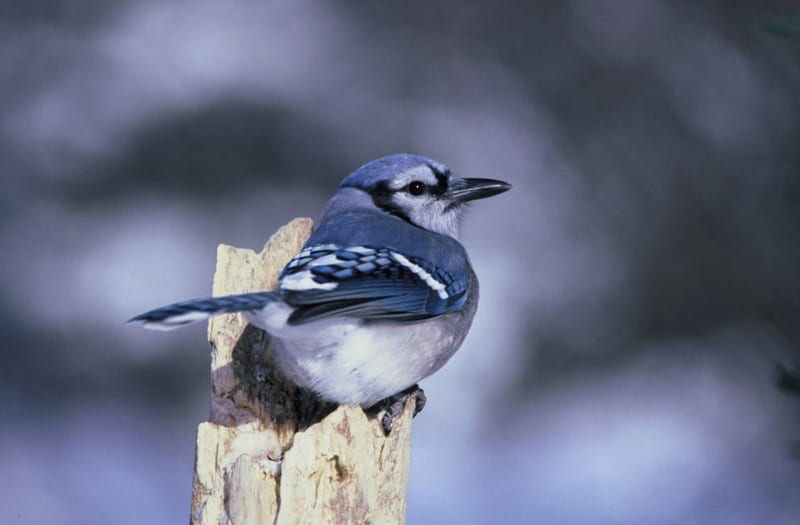
One of the most common backyard birds in Nebraska, the blue jay is a native species that you will find throughout the state, especially in the eastern half. They are present throughout the year, whether it is summer or winter.
The most notable physical characteristic of this large songbird is its various shade of blue on the top, as well as black and white. Under the body, it is light gray or white.
You will find blue jays in almost all kinds of forests in Nebraska, but they are most common in those with oaks.
The blue jay has an omnivorous diet. About 75% of its food includes vegetable matter, such as beechnuts and acorns. It also eats insects, including beetles, grasshoppers, and caterpillars.
You can attract blue jays to your backyard. You will need a birdfeeder with suet, black oil sunflower seeds, and peanuts.
2. Dark-eyed Junco
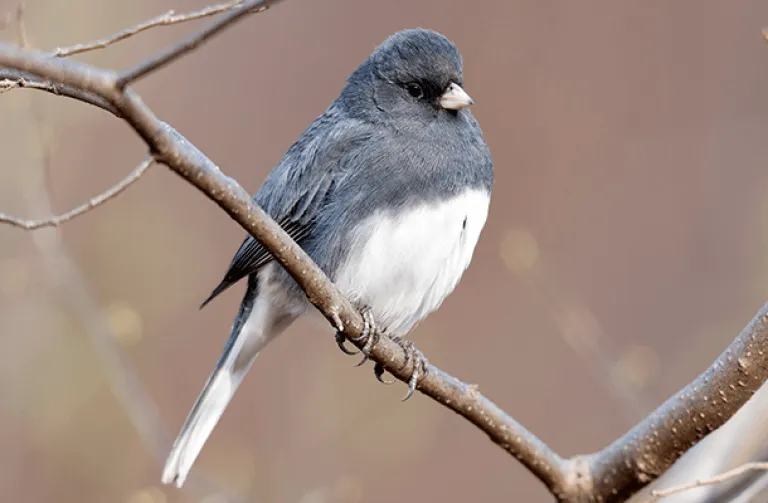
The dark-eyed junco is gray or brown in its upper body, although there can be color variations between regions. The breast, meanwhile, is white in the center and gray around the area.
If you want to see a dark-eyed junco in its natural habitat, you should head to coniferous forests, especially those with spruce, Douglas fir, and pine.
You can lure dark-eyed juncos into your backyards. They are granivorous birds, so make sure to provide grains and nuts.
Dark-eyed juncos are also called snowbirds. This is because they most commonly appear in backyards in the winter.
3. House Sparrow

Unlike most of the other birds on this list that are a joy to see in backyards, many people despise house sparrows. They are considered pests and invasive species, so they are not often welcomed by homeowners.
House sparrows are year-round residents in Nebraska. Although, they are slightly more common in the winter than in summer.
Aside from grains and seeds, the house sparrow will also eat discarded food. It is not uncommon to find them scavenging through bins and making a mess in the yard.
4. White-Breasted Nuthatch

Active and agile, it is common to find white-breasted nuthatches in backyards. They are most common in Nebraska from September to February.
One of the most prominent physical features of the white-breasted nuthatch is its black cap. Meanwhile, the belly and face are white while the back is blue-gray.
The natural habitats of white-breasted nuthatches are woodland edges and deciduous forests. Nonetheless, you will find them even in yards and parks.
Install suet feeders and tube feeders in your backyard if you want the white-breasted nuthatch to come. Fill the feeders with peanuts and sunflower seeds.
5. Northern Cardinal

The list of the most common backyard birds in the Cornhusker State is incomplete without mentioning northern cardinals. They are year-round residents, unlike other birds that migrate depending on the season.
It is almost impossible to miss a male northern cardinal when you see one because of its bright red color. They also have red beaks and crests. On the other hand, females are duller, with most parts being brown.
It is common for northern cardinals to live in areas with dense vegetation where they will forage insects, fruits, and seeds.
6. Black-Capped Chickadee

A year-round resident in Nebraska, the black-capped chickadee has a prominent black cap, which is where the bird got its name. The bib is also black, while the cheeks are white. It is a compact bird with a short neck, a narrow tail, and a spherical body.
The most common habitats of black-capped chickadees are woodlots and forests with woody shrubs and trees.
It is seldom that black-capped chickadees will stay in bird feeders for a long time. Instead, it will grab seeds, fly, and eat somewhere else.
The black-capped chickadee is curious and friendly. If you have seeds in your hand, expect them to come close.
7. Downy Woodpecker
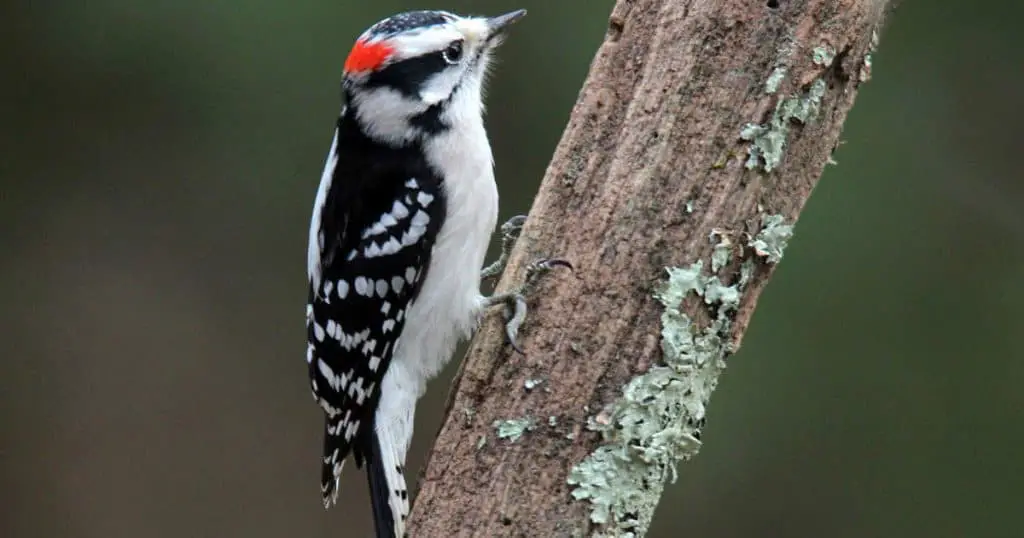
While you will find downy woodpeckers in Nebraska throughout the year, their sightings are most frequent in the winter. You will find them along streams, woodlots, backyards, and city parks.
A downy woodpecker has a large and stocky head, stiff and short tail, and short and chiseled bill. Meanwhile, the head has a black and white stripe with a red spot on the top in males. They also have black wings.
Downy woodpeckers are the smallest woodpeckers in the country. On average, they have a length of 5.5 to 6.7 inches with a wingspan of 9.8 to 11.8 inches.
If you want the downy woodpecker to visit, provide them their favorite food – suet. Although, they will also come to platform feeders with peanuts, millet, and black oil sunflower seeds.
8. Red-Winged Blackbird

The distinctive appearance of the red-winged bird makes its identification easy. Males have glossy black bodies with red shoulder badges. Females, on the other hand, are mostly dark brown.
Males are known for doing almost anything to seek attention. They will sit on high perches and belt a loud song, which is also how they attract a female red-winged blackbird.
If red-winged blackbirds are in your Nebraska birding itinerary, you should head to fresh and saltwater marshes. Nonetheless, you can also see them on golf courses, wet roadsides, and dry meadows.
9. Mourning Dove
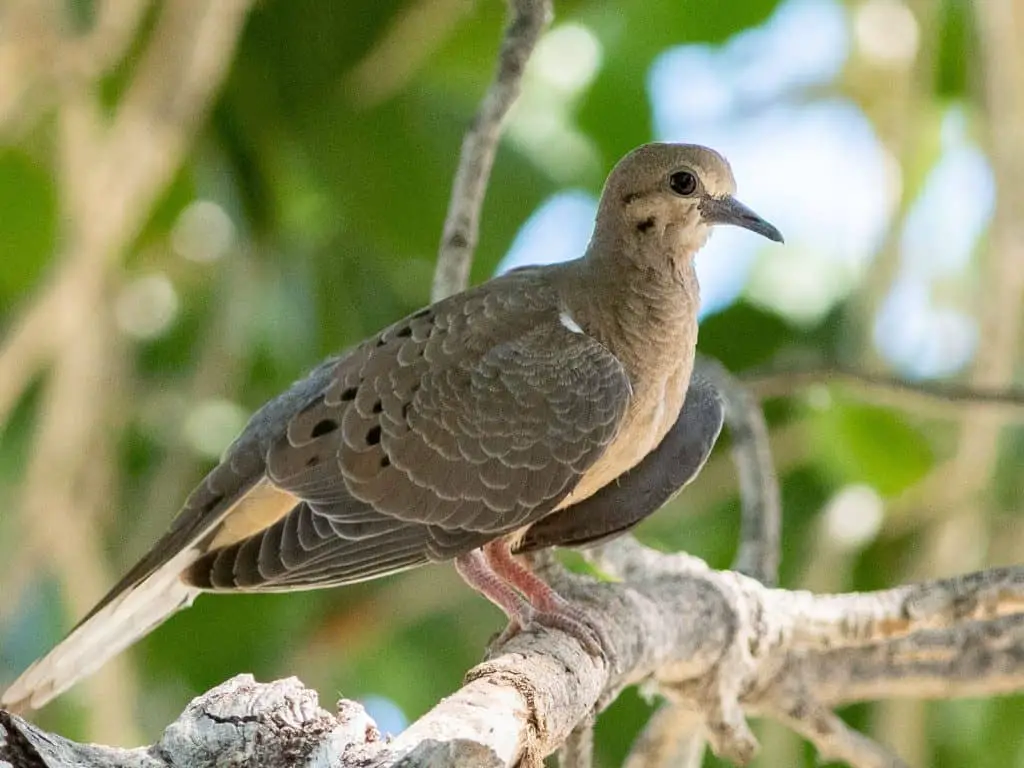
A small and slender dove, this Nebraska bird has a long tail, plump body, small bill, and short legs. The mourning dove is buffy tan to delicate brown with scattered black spots on its wings. Meanwhile, the tail feathers have black borders.
Those who want to see mourning doves in Nebraska should check out woodland edges and open areas like fields and grasslands. They also often perch on telephone wires.
While the mourning dove is a graceful bird, it is known for its sad cooing, which some people might find eerie.
10. Brown-Headed Cowbird

A small blackbird, the brown-headed cowbird has a brown head, as it is named. Meanwhile, the body is black with light brown streaks. It also has a short tail.
Farms and woodlands are some of the most usual places where you will find brown-headed cowbirds. They are frequent in cattle feedlots.
Many people consider brown-headed cowbirds a nuisance. These parasite birds have the habit of destroying the eggs of other birds, especially those that are smaller than them.
11. Red-Bellied Woodpecker
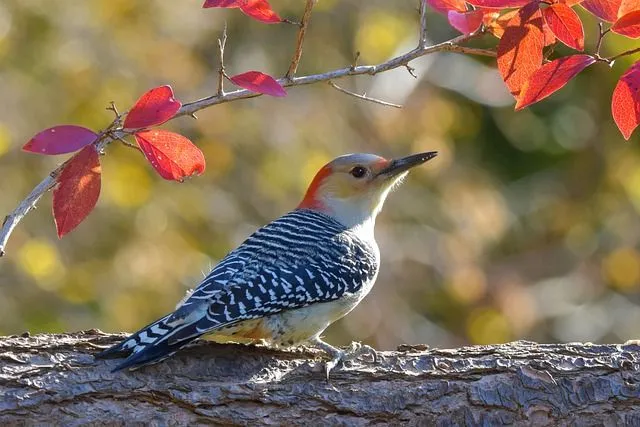
With its name, most people will think that the most prominent feature is its red belly. Nonetheless, it is pale and often hard to spot, especially from a distance.
Red-bellied woodpeckers are present in Nebraska throughout the year, but they are more common in the eastern half of the state.
The bird is noticeable because of its red head, which is also why most people confuse it with red-headed woodpeckers.
These backyard birds in Nebraska eat insects, as well as nuts, fruits, and seeds. They frequently visit bird feeders, especially if your house is near a wooded area.
12. House Wren
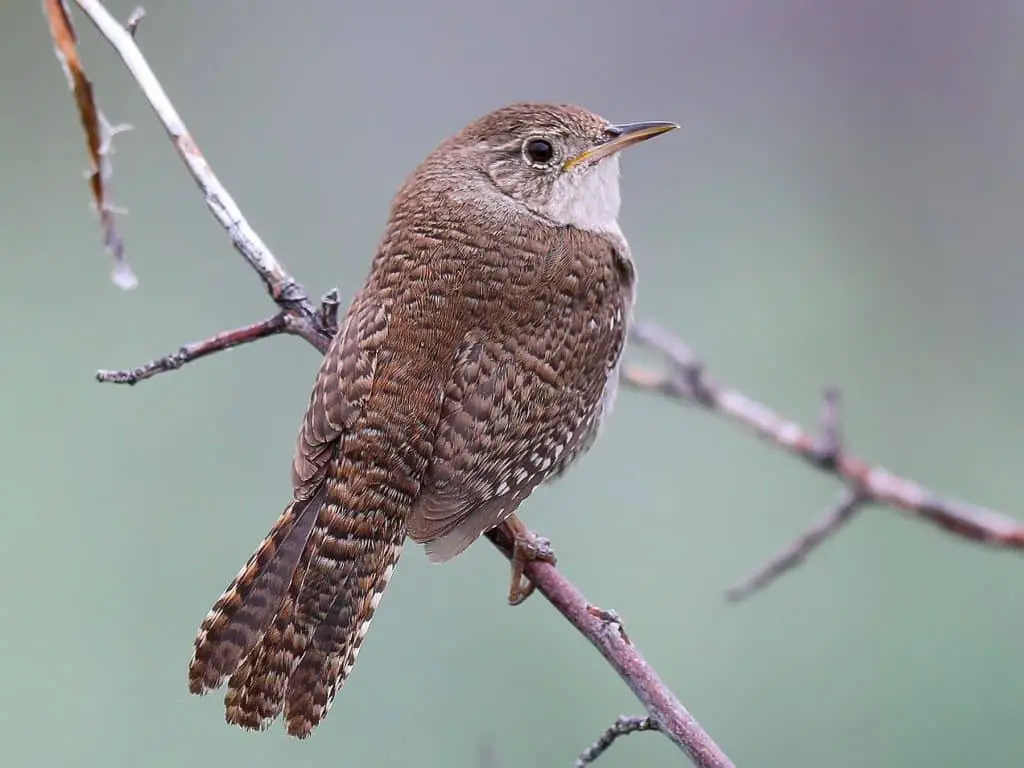
With a length of only 4.3 to 5.1 inches, the house wren is a small bird. Plus, it is subdued brown throughout the body with dark streaks, making them quite difficult to notice.
Despite being small birds, house wrens are known for being energetic. They can be seen hopping while searching for food. More so, they are noticeable because of their cheerful songs.
The habitat of house wrens differs depending on the season. In the summer, you will find them in forest edges and open forests. Meanwhile, they become more secretive in the winter, and they hide in places with brushy tangles and thickets.
13. European Starling

The European starling is a stocky songbird with iridescent blue, green, and purple tones. The color of their plumage can change depending on the season. It has a pointed bill, triangular wings, and slender beaks.
European starlings are almost impossible to miss because they are loud and aggressive. They form large flocks when they travel, often with grackles and blackbirds. They race and probe on the grass as they look for something to eat.
Unlike most of the other birds on this list, many Nebraska residents do not like having European starlings in their backyards. They are invasive species.
14. Northern Flicker
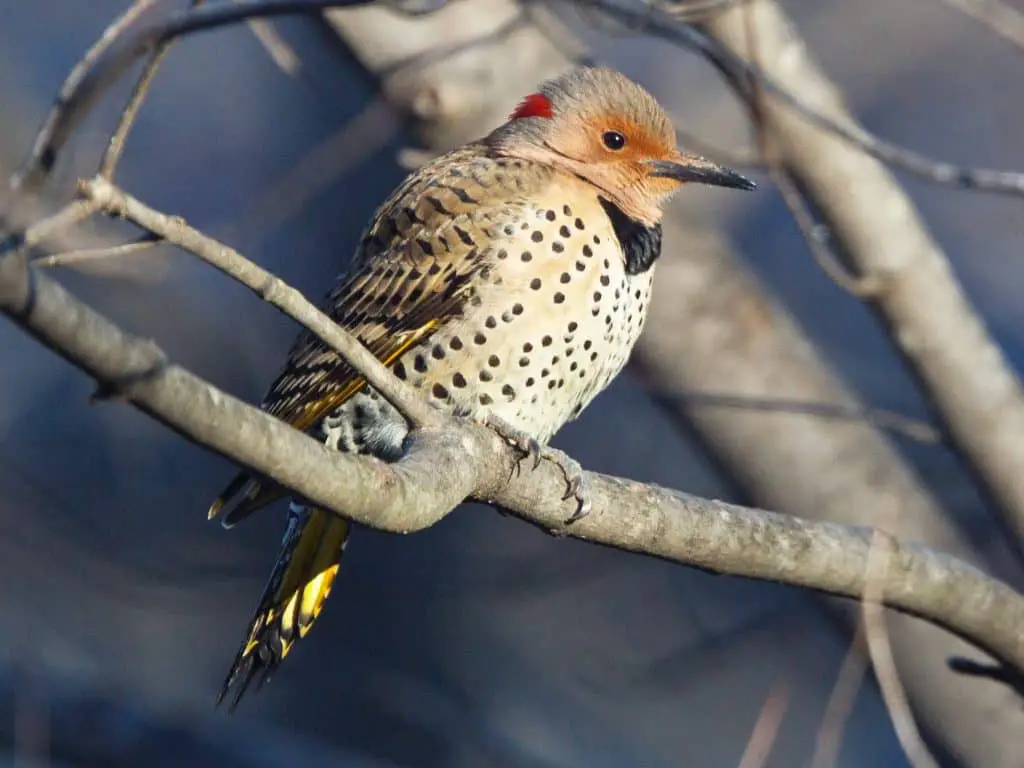
You will see northern flickers in Nebraska throughout the year. Look for them in woodlots, groves, open forests, and semi-open countries.
The northern flicker has a slim and rounded head, a slightly down-curved bill, and a flared tail. As for the color, the body is brownish overall with a white rump that is most visible when the bird is flying.
Fruits, seeds, ants, and beetles are some of the favorites of northern flickers. They will also visit backyard bird feeders with suet. Another great way to lure them into your yard is by adding nest boxes and bird baths.
15. American Crow
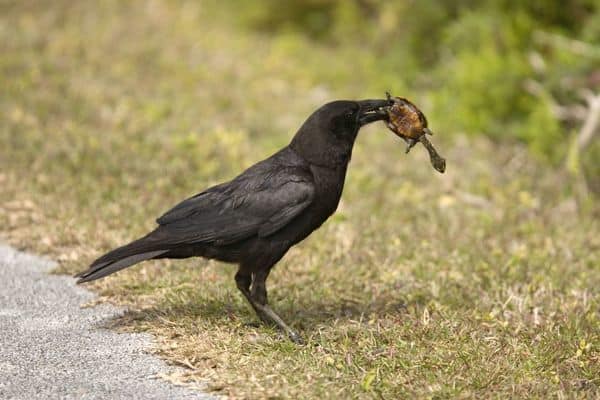
A year-round resident in the Cornhusker State, the American crow is known for being an intelligent bird. They can remember faces for a long time and will also imitate the sounds they hear.
With a length of up to 21 inches, the American crow is larger than most of the other backyard birds in the state. The body is all black, even its bill and legs. It can molt, which will make the feathers scaly or brownish.
You will frequently find American crows in large flocks because they are social birds. They will pick up discarded food and raid trash bins.
16. Barn Swallow

Barn swallows are in Nebraska only during the breeding season, which is from April to October. Outside such, they will migrate to Central and South America.
The barn swallow is a small and slender songbird. The back is deep steel blue. Meanwhile, its tail and wings are reddish-brown. Its tail has outer feathers, giving the bird a deep fork.
If you want barn swallows to come to your backyard, you should set up nest boxes. They can also visit when you have platform feeders with ground-up eggshells.
17. House Finch
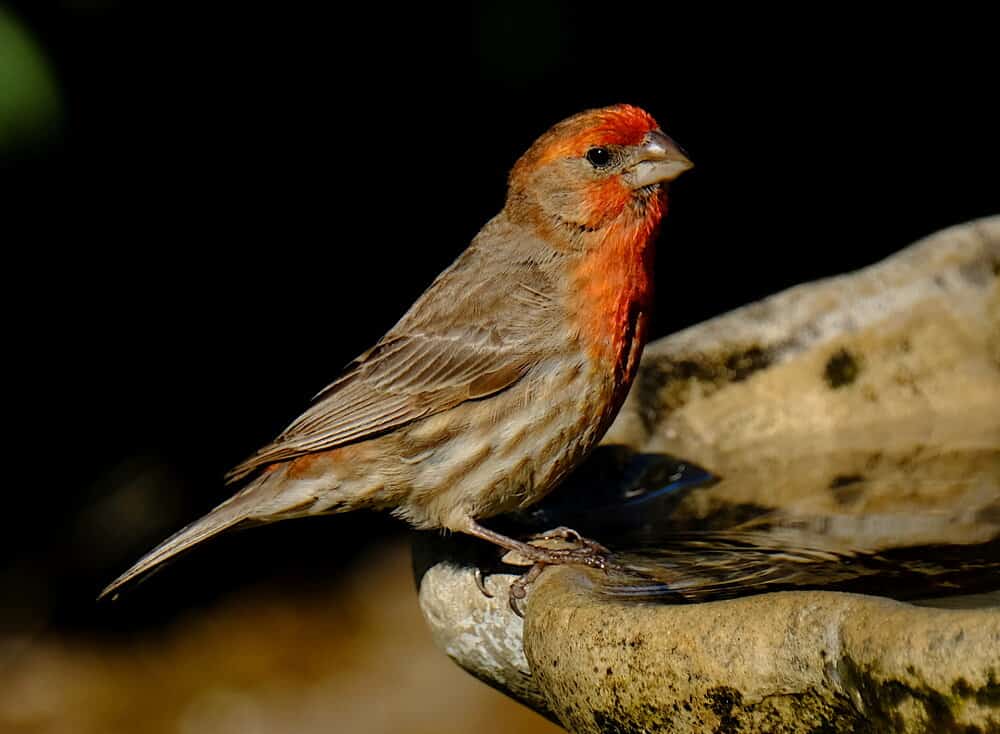
An adaptable and cheerful bird, house finches live in Nebraska throughout the year. They are most frequent in the far western and northeastern parts of the state.
Some of the physical characteristics to watch out for in a house finch are its small bodies, short wings, notched tails, and flat heads. As for the color, the face and upper breast are rosy red while the back has brown streaks.
It is common for house finches to stay in bird feeders. Nonetheless, they will also stay on the ground when searching for food. Their diet includes buds, berries, and seeds, among other vegetable matter.
18. Chipping Sparrow
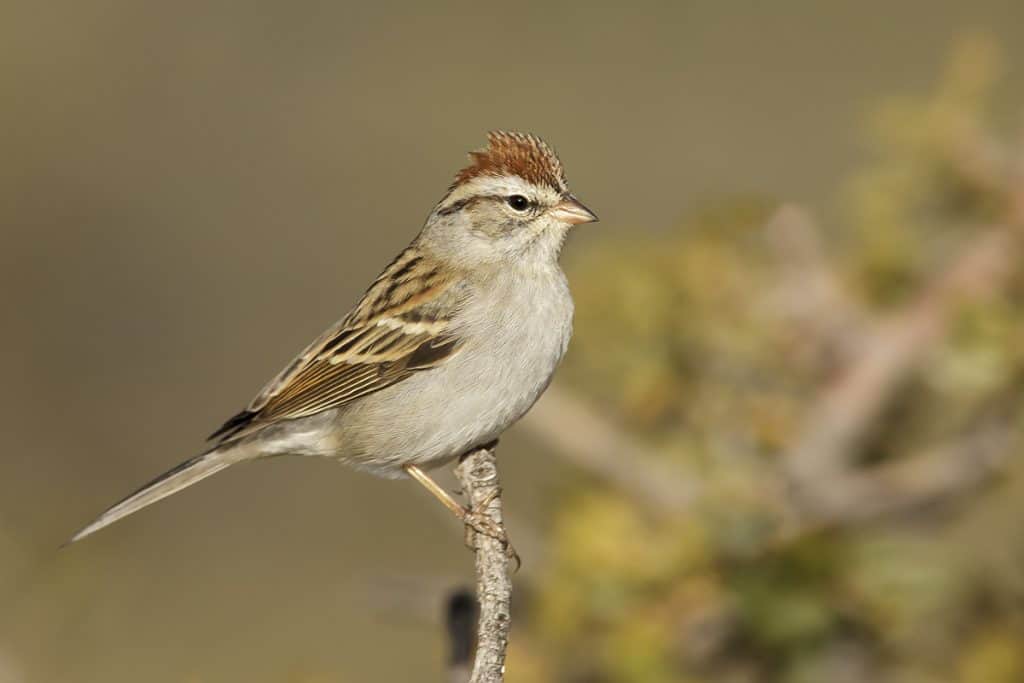
From April to October, you will see chipping sparrows in Nebraska. They spend their breeding season in the state before flying to Florida and Mexico, which is where they spend their winter.
The appearance of chipping sparrows varies by season. In the summer, they have pale faces, frosty underparts, and a rusty crown. Come winter; their color is more subdued with dark streaks under the body.
If you are interested in seeing a chipping sparrow in Nebraska, you should head to grassy conifer woodlands. They are also common on roadsides and parks.
19. Red-Headed Woodpecker

A small woodpecker, the red-headed woodpecker is a migratory bird in Nebraska. You will see them in the state from May to September, although some of them can stay throughout the year.
The red head is one of the distinct features of this bird, as implied by its name. They have black and white markings. More so, it has a stout body, large head, and chiseled bill.
Oak woodlands, forest edges, and farmlands are some of the best places to spot a red-headed woodpecker. They can also visit backyard bird feeders when there is a suet.
20. Song Sparrow

Those who want to see song sparrows in Nebraska should head to the eastern part of the state, where they are present year-round. Meanwhile, in the western part, they stay only in the winter.
The song sparrow is streaky brown, which makes it unremarkable in terms of color. If you look closer, however, you will notice that its head has a mix of brown, red, and gray.
Song sparrows eat seeds and insects. In the summer, they like feeding on ants, wasps, grasshoppers, and caterpillars. Meanwhile, in the winter, they prefer seeds.
21. Hairy Woodpecker

To easily identify a hairy woodpecker, some of the things to look at are its chisel-like bill, square head, and stiff tail feathers. The body has a black and white pattern. Meanwhile, the wings are black with white spots.
It is common for hairy woodpeckers to be hitching on tree trunks. They can also feed at the bottom of trees, as well as in fallen logs. At times, they will be foraging on the ground.
For their habitats, hairy woodpeckers thrive in mature forests. They also like hanging out in parks, cemeteries, and woodlots.
22. Orchard Oriole
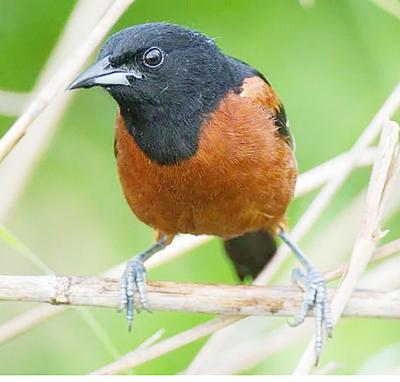
If you are looking for colorful birds in the Cornhusker State, orchard orioles should be on your itinerary. Males have black and brown wings with a reddish-chestnut patch. On the other hand, females have greenish-yellow bodies and two white wing bars.
When foraging, you will see orchard orioles on the top of trees, looking for insects to consume. They can also visit feeding stations and hummingbird feeders. It is also common for these birds to drink nectar from flowers.
You will find orchard orioles in open shrublands and woodlands, as well as backyards and farms. They are most likely to be present in locations with scattered trees.
23. Common Yellowthroat
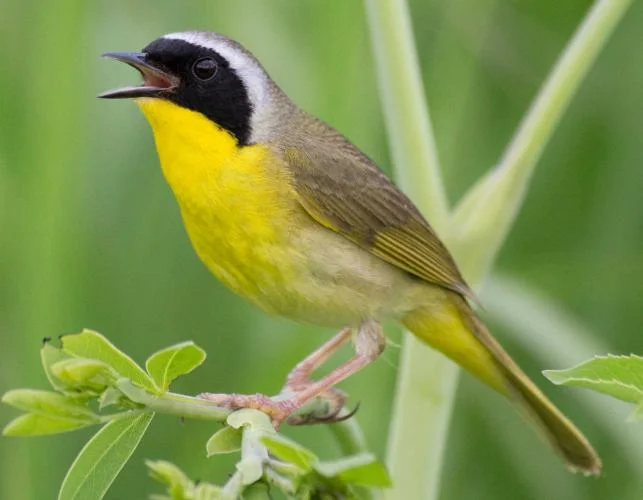
The vibrant color of the common yellowthroat makes it almost impossible to miss. It is small but easily noticeable because of the bright yellow throat. Males have olive upperparts and a black face. On the other hand, females are mostly olive-brown throughout the body but also have a yellow coloration on the throat.
In most instances, common yellowthroats are on the ground, especially in dense fields and thickets, where they are looking for tiny insects to eat. Spiders also form a major part of their diet.
The best time to see common yellowthroats in Nebraska is from April to October. They only stay in the state during their breeding season.
24. Cedar Waxwing
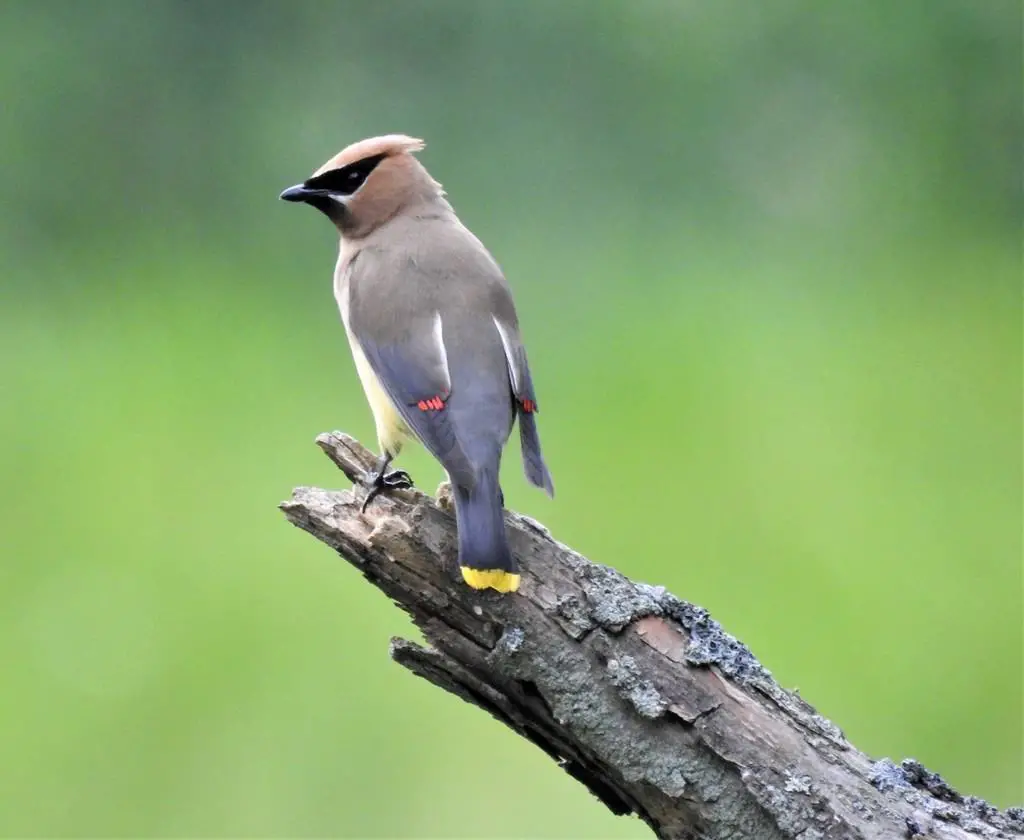
The colors of the cedar waxwing make them commanding. They have lemon yellow markings on their brown bodies. Meanwhile, the entire face is covered by a black mask.
They stay in Nebraska throughout the year. Nonetheless, they are not as common as the other species on this list.
These Nebraska birds can visit backyards, especially when you have native shrubs and trees, including winterberry, juniper, and dogwood.
Cedar waxwings eat fruits most of the time. They are occasionally intoxicated because they eat fermented berries with high alcohol content.
25. Eastern Kingbird

In the summer, eastern kingbirds are abundant in Nebraska. They spend their breeding season in the state from April to September. If you want to see them during these months, you should head to forest edges, orchards, and fields.
The eastern kingbird is mostly black and white throughout its body. The head is black but darker than the other parts. The tail is also black with a white tip.
For its diet, the eastern kingbird will eat mostly insects, including bees, wasps, winged ants, and beetles.
Ever wondered why they are called kingbirds? The latter is a reference to their aggressive personality. They will courageously defend their nests against attackers.
26. Western Meadowlark

Seeing a western meadowlark is a treat. It has a vibrant yellow belly that makes the bird stand out. Aside from its color, it also has a melodious song, which makes it easy to detect its presence in a specific location.
It is possible to attract western meadowlarks in your backyard, especially when you have bird feeders with cracked corn and hulled sunflower seeds. They also eat insects.
The western meadowlark is the state bird of Nebraska, as well as Kansas, Montana, North Dakota, Oregon, and Wyoming.
27. Yellow Warbler
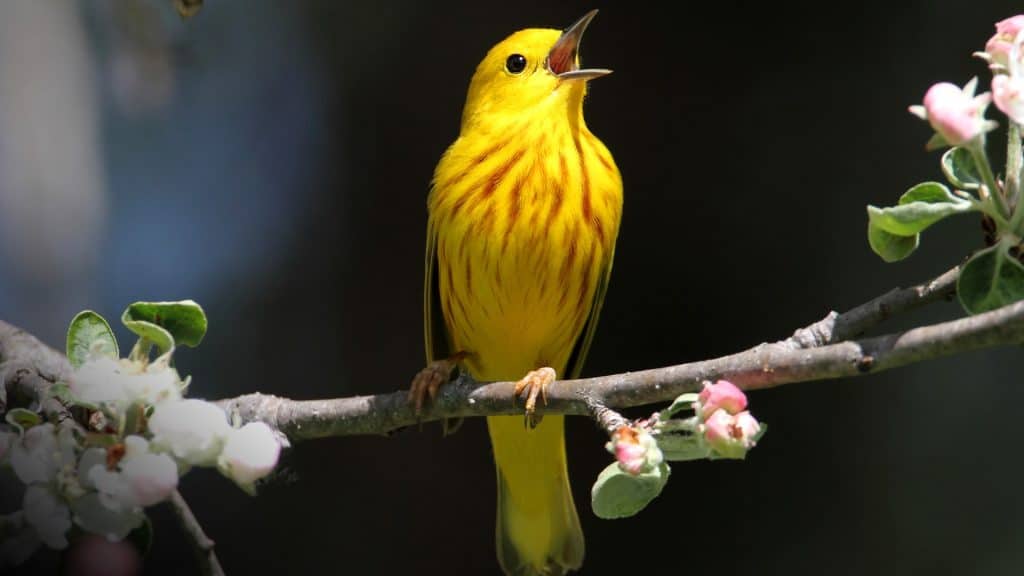
While they are small birds, yellow warblers are easily identifiable. They have uniformly yellow bodies, but males are brighter than females.
Yellow warblers are known for being cheerful. They have happy and sweet whistled songs, which are sure to be music to your ears.
Shrubby woods and thickets are the most common habitats of yellow warblers. They like locations with alders, cottonwoods, and willows. Wetlands and streams are also preferred habitats.
They can even come to your backyard. Lure them with peanut butter, oranges, and suet. There is also a higher chance that they will visit if you have plants that bear berries.
28. American Goldfinch

While it has a length of only 4.3 to 5.1 inches, American goldfinches are head-turners. They have bright yellow bodies that are guaranteed to command attention. Males are brighter than females.
They are a sight to behold not only because of their color but also their behaviors. American goldfinches are active and acrobatic. They are bouncy in flight with an undulating pattern.
The natural habitats of American goldfinches include floodplains and woody fields. They are also common in cultivated areas, as well as private backyards. You can attract them to the garden by planting milkweed and thistle.
29. Baltimore Oriole
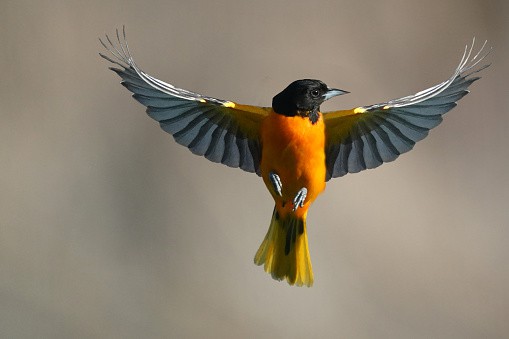
In the breeding season, which runs from April to September, there is a high chance that you will see Baltimore orioles in Nebraska. They are among the first signs of spring in the state.
Males are handsome with their bright orange and black bodies with white wing bars. Females, meanwhile, are often duller.
If you want to see Baltimore orioles in Nebraska, you should head to forest edges, riverbanks, and open woodlands.
Baltimore Orioles will eat fruits, such as cherries, bananas, mulberries, and raspberries. They also like insects, including grasshoppers, crickets, and beetles.
30. Warbling Vireo

A migratory bird, the warbling vireo is present in Nebraska only during the breeding season. When it is done, they will move to Central and South America.
The warbling vireo is small and chunky with a thick and straight bill. The upper body is gray-olive. It has a dark line that runs through its eyes.
While it is a plain-looking bird, it is not boring. It is known for its rich and joyful song, which is also where the bird got its name. It has melodious calls that males use for attracting females and communicating with other birds.
Roaming Tip: And you thought that crooners were the likes of Sinatra, Como, and Crosby, eh? Try listening in to this group and tell us what you think — Birds Of Tennessee.
Watch This!
Frequently Asked Questions
What is the most common bird in Nebraska?
The most common bird in Nebraska is the American robin. It lives in both urban and suburban locations in the state. American robins are also well-adapted to humans, so they are a common sight even in private backyards and parks in Nebraska.
Where can I go bird-watching in Nebraska?
If you fancy a bird-watching trip in Nebraska, some of the best spots to check out are Branched Oak State Recreation Area, Crescent Lake National Wildlife Refuge, Ponca State Park, Indian Cave State Park, Harlan County Reservoir, Fort Kearny State Historical Park, Spring Creek Prairie Audubon Center, and Fontanelle Forest, among others.
What big birds live in Nebraska?
Some of the most common big birds living in the Cornhusker State are red-tailed hawks, sharp-shinned hawks, broad-winged hawks, Cooper’s hawks, eastern screech owls, great-horned owls, turkey vultures, golden eagles, and bald eagles.
How many species of birds are in Nebraska?
According to the Nebraska Ornithologists’ Union, there are 467 bird species in the state. 346 of these birds are classified as regular residents. Meanwhile, 19 species are casual, and 97 are accidental. There were also two extirpated and two extinct species.
Conclusion
Nebraska is a birding paradise. There are hundreds of species roaming free in the wild. You will also find tons of these birds visiting backyards, especially those with bird feeders. Above, we have identified their most common physical characteristics, habitats, and feeding behaviors, making it easy for you to differentiate one from the other.
Are there other Nebraska birds that we forgot to mention? Leave a comment below and share with us what else have you found in the state.

